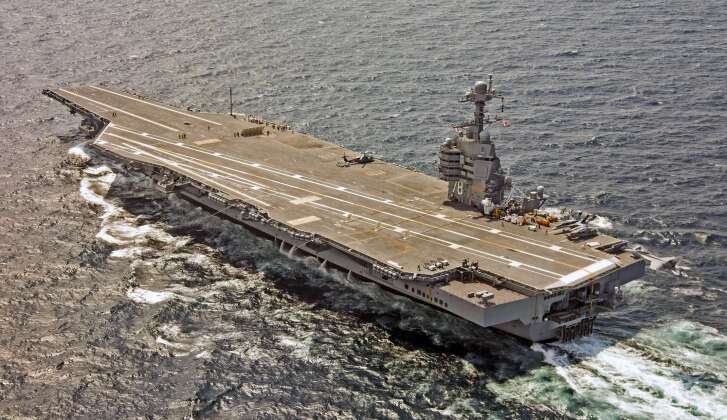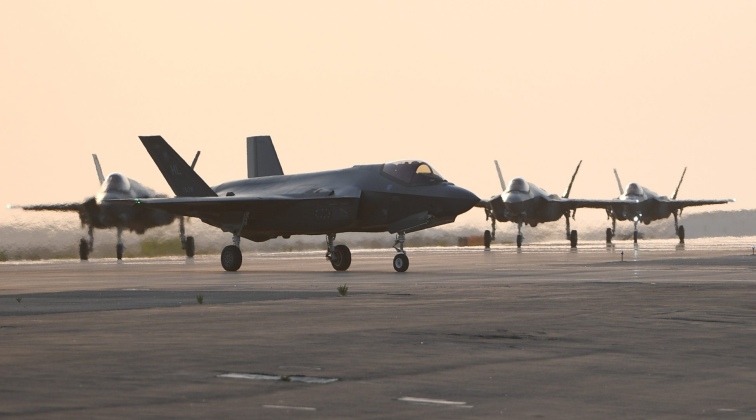Military Watch:
U.S. Struggling to Finance Middle East Military Surge: Budgetary Crisis Threatens Pentagon Supply Chains

U.S. Marines in Saudi ArabiaKyle Talbot
The Untied States has struggled to finance its large military buildup in the Middle East, which began in early October in response to the outbreak of hostilities between Israel and various Palestinian militia groups based in the Gaza Strip.
A primary issue has been a gridlock in the U.S. Congress, which has been unable to approve new funding due to disagreements between the Democratic and Republican parties over whether to include tens of billions of dollars in aid to Ukraine in new spending packages.
This has left several federal agencies, including the Department of Defence, operating under stopgap funding bills, which freeze all types of defence spending at levels seen in 2022. Such levels are considered insufficient to cover the U.S. Military’s expenses particularly due to the significant costs associated with overseas operations on such a large scale.
Pentagon spokesman Chris Sherwood informed Politico that since the massive redeployment of U.S. forces to the Middle East was not planned in advance, the military “had to pull money from existing operations and maintenance accounts.” This resulted in less funding being available for previously planned exercises and deployments elsewhere. “We’re taking it out of hide,” he concluded.

U.S. Navy Supercarrier USS Gerald Ford
American defence officials have repeatedly warned that the lack of funding resulting from the congressional impasse could harm shipbuilding, procurement programs, and the industrial base itself.

U.S. Navy Supercarrier USS Gerald Ford
American defence officials have repeatedly warned that the lack of funding resulting from the congressional impasse could harm shipbuilding, procurement programs, and the industrial base itself.
This followed multiple government reports highlighting that the sharp decline of the American industrial base over the past 30 years has seriously undermined the country’s ability to compete in defence.
Deputy Under Secretary of Defence Radha Plumb warned to this effect of an “additive domino effect of delays” which could be devastating for firms across the Pentagon’s supply chains.
Under Secretary of Defence Bill LaPlante highlighted that a lack of Pentagon funding could lead to further layoffs in contractor firms.
Difficulties financing the Pentagon budget, as well as maintaining spending in the hundreds of billions of dollars to sustain the war effort in Ukraine, have contributed to the more than doubling of the American budget deficit which reached $2.02 trillion for the fiscal year through September compared to just $1 trillion for the preceding year.
Massive debt accumulation has meant that by some estimates 2023 will be the first year where the costs of servicing the interest on American debt will alone exceed the entire Pentagon budget.

U.S. Air Force F-35s at Al Dhafra Airbase, UAE
Regarding the scale of the American military surge in the Middle East, among the most notable assets deployed have been a Marine Rapid Response Force led by the amphibious carrier USS Bataan, two U.S. carrier strike groups led by Nimitz and Gerald Ford class nuclear powered supercarriers, A-10 attack jets from the 354th Fighter Squadron, F-15E strike fighters, Patriot and THAAD air defence systems, and a range of other aerial warfare assets.

U.S. Air Force F-35s at Al Dhafra Airbase, UAE
Regarding the scale of the American military surge in the Middle East, among the most notable assets deployed have been a Marine Rapid Response Force led by the amphibious carrier USS Bataan, two U.S. carrier strike groups led by Nimitz and Gerald Ford class nuclear powered supercarriers, A-10 attack jets from the 354th Fighter Squadron, F-15E strike fighters, Patriot and THAAD air defence systems, and a range of other aerial warfare assets.
While American officers are confirmed to have been deployed to advise Israeli forces on the ground, and drones have been deployed for the first time for operations over the Gaza Strip, American special forces are also reported to have engaged Palestinian militias in combat.
The United States has simultaneously maintained significant commitments elsewhere, with personnel deployments to Ukraine having surged in 2022 and deployments both covertly on and overtly around Taiwan increasing significantly in 2023.
No comments:
Post a Comment